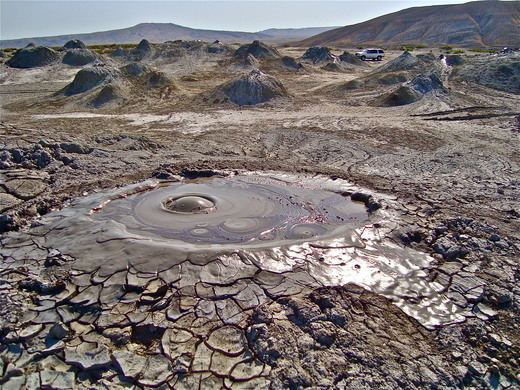 | ||
Similar Qal'eh Hasan Ali, Sharat Kovakab, Ile des Cendres, Bazman, Lower Chindwin | ||
Mud volcanoes in azerbaijan
Azerbaijan has the most mud volcanoes of any country, spread broadly across the country. 350 of the 800 volcanoes of the world are in the Azerbaijani Republic. Local people call them “yanardagh” (burning mountain), “pilpila” (terrace), “gaynacha” (boiling water) and “bozdag” (grey mountain) alongside its geographical name – mud volcanoes.
Contents
- Mud volcanoes in azerbaijan
- Map of Mud volcanoes Azerbaijan
- Submarine mud volcanoes
- Eruption of mud volcanoes
- Interesting facts
- References
Map of Mud volcanoes, Azerbaijan
Submarine mud volcanoes
Underground and submarine mud volcanoes are also famed in Azerbaijan. There are more than 140 submarine volcanoes in the Caspian Sea. Eight islands in the Baku Archipelago are mud volcanoes by origination. The other kind of mud volcanoes are wells. Their activity can be observed among strata of various ages. According to the information, mud volcanoes initially began their activity in the territory of Azerbaijan 25 million years ago.
Eruption of mud volcanoes
About 200 eruptions have occurred in 50 volcanoes in the territory of Azerbaijani Republic since 1810. Eruption of mud volcanoes is accompanied by strong explosions and underground rumbling. Gasses come out from the deepest layers of the earth and immediately ignite. A height of a flame over volcano reaches 1000 meters (Garasu volcano). Toragay volcano erupted 6 times from 1841 to 1950.
Mud volcanoes are associated with oilfields. Rich oil and gas fields are found in the territories of mud volcanoes (Lokbatan, Garadgh, Neft Dashlari, Mishovdagh and others). In addition, lava, mud and liquid erupted by mud volcanoes are used as raw materials in chemical and construction industries and also in pharmacology.
